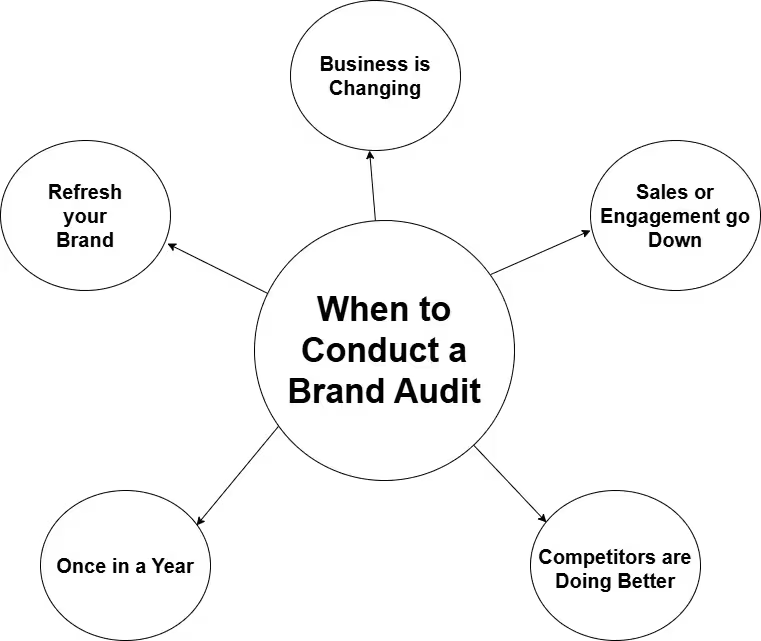How to Conduct a Brand Audit - A Step-by-Step Guide to Evaluating Your Brand’s Health
Every brand tells a story, and over time, that story can shift without us even realizing it. A brand audit helps you pause, take a closer look, and understand how your brand is truly performing. It is a deep dive into how people see your business, how consistent your message is, and whether your marketing is aligned with your goals.
Think of a brand audit as a health check for your business. It helps you find what is working well, what requires improvement, and where new opportunities might be hiding. Whether you are launching a new campaign, rebranding, or trying to stay ahead of your competitors, a brand audit provides the clarity and confidence to make smarter decisions. Let’s explore ten practical steps to help you conduct a successful brand audit from start to finish.
When to Conduct a Brand Audit
A brand audit is not something you do only once. It should be a regular part of your business management. Knowing when to do it helps you get the best results. Below are some good times to conduct a brand audit.

1. When your business is changing
If your company is growing, entering new markets, or reaching new customers, it is a good time to check if your brand message still fits who you are and what you offer.
2. When sales or engagement go down
If you notice fewer visitors, less interest on social media, or fewer sales, a brand audit can help you find out what is not working.
3. When you plan to refresh your brand
Before you change your logo, website, or brand style, do an audit first. It helps you understand what should stay the same and what should be improved.
4. When competitors are doing better
If other brands are becoming more popular or visible, it is time to look at what they are doing differently and how you can stand out again.
5. Once every year
Even if everything seems fine, doing a brand audit once a year helps you stay on track and keep your brand consistent and strong.
How to Run a Brand Audit That Strengthens Your Business
Define Your Brand Audit Goals
Before you begin your brand audit, it is essential to be clear about what you want to achieve. A brand audit can cover many areas, so having clear goals helps you stay focused and get meaningful results.
Start by asking yourself some key questions,
- What do I want to learn from this audit?
- Am I trying to understand how people see my brand?
- Do I want to find out if my marketing is effective?
Am I preparing for a rebrand or a product launch?
Your answers will guide the entire process. For example, if your goal is to improve brand awareness, you will focus on your visibility, reach, and consistency across channels. If your goal is to strengthen customer trust, you might look closely at your reviews, social media presence, and brand tone.
It also helps to set measurable goals, like increasing social engagement, improving website traffic, or raising customer satisfaction scores. Clear goals make it easier to track progress and see the value of your audit. In short, defining your brand audit goals gives you direction. It ensures you spend your time on the right things and end up with useful insights that help your brand grow stronger.
Review Your Brand’s Core Identity
Your brand’s core identity is the heart of who you are as a business. It includes your mission, vision, and values, the things that guide every decision you make and shape how people see your brand.
Start by taking a close look at your mission statement. Does it reflect what your company stands for today? Over time, businesses grow and change, and sometimes the original mission no longer matches what the brand has become. If that is the case, it might be time to update it.
Next, review your vision. Your vision describes where you want your brand to go in the future. Make sure it is still clear, realistic, and inspiring for your team and your customers.
Then, check your brand values. These are the beliefs and principles that guide how your business operates. Ask yourself if your actions truly reflect those values. For example, if one of your values is “customer first,” are you really putting customer needs at the center of your strategy?
You can also talk to your team and customers to see how they describe your brand. If their answers are different from what you expect, that may be a sign that your brand identity needs to be clearer or more consistent. In short, reviewing your brand’s core identity helps you make sure your brand’s purpose and direction are still aligned with who you are today and where you want to go tomorrow.
Analyze Your Visual and Verbal Branding
Your visual and verbal branding is what people first notice about your business. It includes how your brand looks and sounds across all platforms. Analyzing these elements helps you make sure your brand feels consistent and professional everywhere.
Start with your visual identity. Look at your logo, color palette, fonts, and imagery. Are they still modern, clear, and aligned with your brand’s personality? If your visuals feel outdated or inconsistent, it might confuse your audience or make your brand look less trustworthy.
Check your marketing materials, such as your website, social media posts, brochures, and packaging. Ask yourself:
- Do they all use the same colors and fonts?
- Does the logo appear correctly everywhere?
- Do the visuals reflect the same mood and tone?
Next, review your verbal branding, which is how your brand speaks to people. This includes your tagline, messaging, and tone of voice. Is your language friendly, formal, or casual? Most importantly, is it the same across all platforms, from your website to your social media captions and customer emails?
Consistency builds recognition and trust. When people see and hear the same brand voice and style every time, they remember you more easily and feel more confident in what you offer.
Take notes on what works well and what needs improvement. You can also ask a few customers or colleagues how they perceive your visuals and messages, their feedback can reveal things you might not notice yourself.
A great example of strong visual and verbal branding is Lay’s. When people began to forget that Lay’s chips come from real farm-grown potatoes, the brand refreshed its look and message. The new design uses warmer colors, a cleaner logo, and packaging that highlights real ingredients, and the message “Real Potatoes.”This update shows how visuals and words can work together to tell a brand’s story and keep it feeling real and relatable.

In short, analyzing your visual and verbal branding helps you keep your brand identity strong, recognizable, and aligned with your overall goals.
Audit Your Website and Digital Presence
Your website and digital platforms are often the first places people go to learn about your brand. That is why auditing your online presence is a key part of a brand audit. It helps you see how your brand performs online and whether your digital spaces reflect your values and message.
Start with your website. Visit it as if you were a new customer. Is it easy to navigate? Does it load quickly? Is the information up to date and useful? A slow or confusing website can make people lose interest fast. Also, check if your visuals, colors, and tone match the rest of your branding.
Look at your content too. Are your product descriptions, blog posts, and landing pages clear and engaging? Make sure your content speaks directly to your target audience and supports your brand message.
Next, review your search visibility. Try searching your brand name and related keywords on Google. Where does your website appear? If it is not ranking well, you might need to improve your SEO by using relevant keywords, optimizing images, and updating old content.
Don’t forget your digital presence beyond your website. Check your listings on platforms like Google Business, review sites, and directories. Make sure all your business details, such as your name, address, and contact information, are accurate and consistent everywhere.
A great example of a strong digital presence is Nike. Its website is clean, fast, and easy to use, with bold visuals that match its energetic brand. Whether you visit Nike’s website, Instagram, or app, everything feels connected. They use the same tone, colors, and message about motivation and performance that appear everywhere. This consistency makes the brand instantly recognizable and trustworthy. When your online spaces match your brand’s look and voice, people remember you and feel more connected.

Overall, a good website and strong digital presence make your brand look professional and trustworthy. They help people find you easily, learn about your products or services, and feel confident choosing your brand.
Analyze Your Social Media and Online Data
Social media plays a big role in how people see and connect with your brand. It shows your personality, values, and how you engage with your audience. Analyzing your social media and online data helps you understand what is working good and what needs to be improved.
Start by looking at your social media profiles. Check if your profile photos, bios, and descriptions are consistent with your brand identity. Your logo, color pattern, and tone of voice should match what you use on your website and other materials.
Next, review your content performance. Check which posts people like, comment on, and share the most. It helps you know what works best. For example, if videos or behind-the-scenes posts perform better, you can create more of that type of content.
It is also helpful to check your engagement rate. Are people interacting with your posts or just scrolling past them? A healthy level of engagement shows that your audience feels connected to your brand.
Use your platform insights or tools like Google Analytics, Meta Insights, or social media dashboards to track key data such as reach, impressions, clicks, and follower growth. This data tells you how visible and active your brand is online.
Finally, pay attention to online mentions and reviews. What are people saying about your brand? Are the comments positive, or do you notice common complaints? Understanding this helps you see how your brand is perceived and where you can improve your reputation.
Analyzing your social media and online data gives you a clear picture of your brand’s digital health. It helps you make smarter content decisions, strengthen your presence, and build deeper connections with your audience.
Gather Customer and Market Insights
Your customers and the market give you the most honest view of how your brand is doing. Gathering insights from them helps you understand what people think about your brand, what they like, and where you can do better.
Start by listening to your customers. Read online reviews, feedback forms, and social media comments. Pay attention to common themes. Are consumers happy with your products or services? Do they mention good customer support, or are there issues you need to fix? Real feedback gives you clues about how your brand is performing in the real world.
Next, conduct surveys or interviews. Ask customers simple questions such as how they discovered your brand, what they think of your quality, and how likely they are to recommend you. These insights help you see what people truly value about your brand.
It is also useful to study your market. Look at your competitors and note how they position themselves. What are they doing better? Where do you stand in comparison? Understanding your competitors helps you spot new opportunities and identify areas where you can stand out.
If possible, analyze industry trends to see how customer preferences are changing. This helps you keep your brand fresh and relevant in a fast-moving market. A great example of gathering customer and market insights is Coca-Cola. The brand constantly listens to its customers through surveys, social media, and feedback campaigns. When people started choosing healthier options, Coca-Cola noticed the trend and introduced products like Coca-Cola Zero Sugar to meet changing tastes.

Gathering customer and market insights gives you a clear picture of how people see your brand from the outside. It helps you make smarter decisions that are based on real opinions and market needs, not just assumptions.
Assess Internal Brand Perception
Your employees and team members are an important part of your brand. They represent your values and help shape how customers experience your business. Assessing internal brand perception means checking how well your team understands and connects with your brand.
Start by asking the employees what they think your brand stands for. Do their answers match your mission and values? If people within your company describe the brand in very different ways, it might mean your internal communication needs improvement.
You can also conduct short surveys or group discussions. Ask if they feel proud to represent the brand, and if they believe your values are visible in daily work. Employees who understand and believe in your brand help create a stronger and more consistent experience for customers.
A great example of assessing internal brand perception is Google. The company regularly checks how employees feel about their workplace and brand through surveys and open discussions. Google’s goal is to make sure its team understands and believes in its mission. When employees feel connected to the mission, they naturally become stronger brand ambassadors.
Evaluate Brand Performance Metrics
Numbers tell a big part of your brand story. Evaluating your brand performance metrics helps you see how well your strategies are working and whether you are reaching your goals. Start by looking at data from your website, such as traffic, time spent on pages, and conversion rates. This shows how effectively your website attracts and engages visitors.

Next, review your social media metrics, including engagement, reach, and follower growth. These numbers reveal how active and visible your brand is online. You should also check your sales and customer data. Are sales increasing? Are customers returning or referring others to your brand? These trends show the real-world impact of your brand performance.
Finally, use tools such as Google Analytics or built-in social media insights to track your progress over time. This helps you find patterns and make better decisions for the future.
Identify Strengths, Weaknesses, and Opportunities (SWOT)
Once you have all your data and feedback, it is time to bring everything together in a simple SWOT analysis. It stands for Strengths, Weaknesses, Opportunities, & Threats.
- Strengths are what your brand does well. It may be a loyal customer base, great service, or strong visuals.
- Weaknesses are areas that need improvement, such as poor online visibility or outdated messaging.
- Opportunities are new chances to grow. It may be a new audience or social platform to explore.
- Threats are challenges that could affect your brand, such as new competitors or changing trends.
Writing all these down helps you clearly understand what to protect, fix, and focus on.
Form Your Brand Audit Report and Action Plan
The final step is turning everything you found into a clear action plan. Your brand audit report should summarize your findings, highlight key insights, and outline what to do next. Start by listing your most important takeaways from each step. Then, set clear actions, for example, updating your website visuals, improving your social media strategy, or refining your tone of voice.
Assign responsibilities to team members and create a timeline for each task. This makes sure your ideas turn into real improvements.
Keep your report simple and easy to understand. A good brand audit report should help everyone in your business see where the brand stands today and what steps will make it stronger tomorrow.
It’s Time to Take Action
A brand audit is not only about finding mistakes, it is about discovering opportunities to grow and improve. It helps you understand how your brand looks, sounds, and feels to both customers and employees. When you take time to review your identity, digital presence, customer feedback, and performance, you gain a clear view of your brand’s true health.
Doing a brand audit regularly keeps your brand consistent, trusted, and ready for the future. It is one of the best ways to make sure your business stays strong, relevant, and connected to the people who matter most, your customers.
If you need expert guidance, we at Become can help you carry out a complete brand audit and build a clear action plan. With professional insight and practical steps, Become helps you shape a brand that stands out and connects deeply with your audience.



















.svg)
